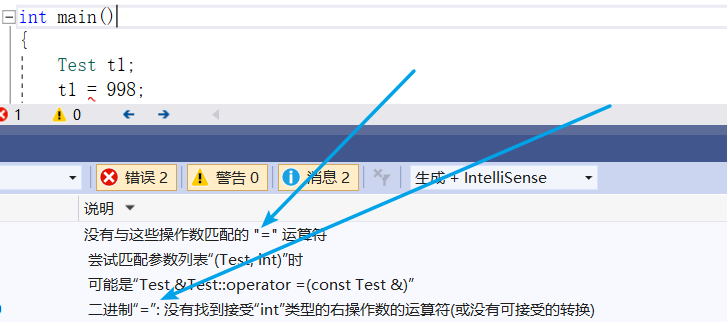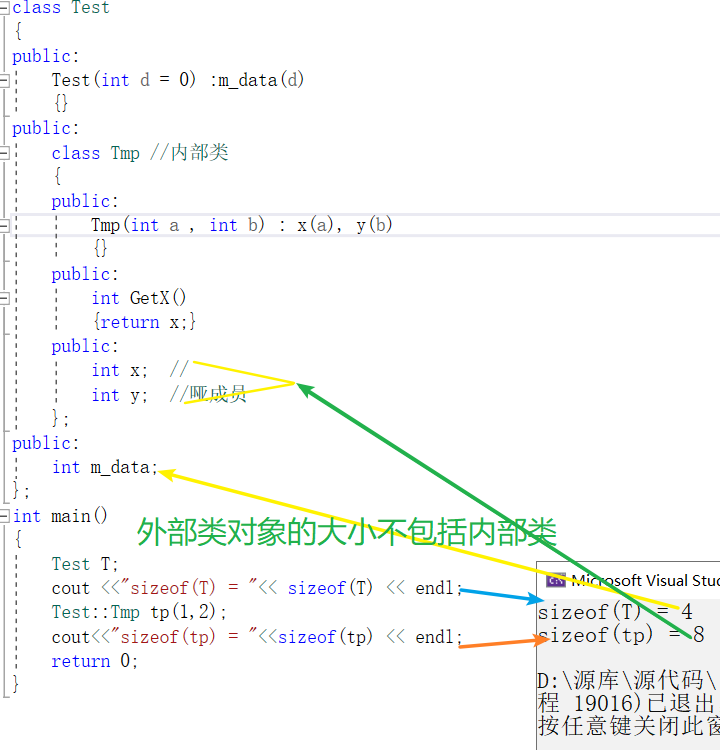一
短整形运算符重载
//短整形运算符重载
#define _CRT_SECURE_NO_WARNINGS
#include <iostream>
#include <string.h>
using namespace std;
class Int
{
public:
Int(long i = 0) : m_i(i)
{}
Int(const Int& x)
{
this->m_i = x.m_i;
}
public:
Int operator+(const Int& x)
{
return Int(this->m_i + x.m_i);
}
Int operator-(const Int& x)
{
return Int(this->m_i - x.m_i);
}
Int operator*(const Int& x)
{
return Int(this->m_i * x.m_i);
}
Int operator/(const Int& x)
{
return Int(this->m_i / x.m_i);
}
Int operator%(const Int& x)
{
return Int(this->m_i % x.m_i);
}
public:
Int& operator+=(const Int& x) // a += b;
{
this->m_i += x.m_i;
return *this;
}
Int& operator-=(const Int& x)
{
this->m_i -= x.m_i;
return *this;
}
Int& operator*=(const Int& x)
{
this->m_i *= x.m_i;
return *this;
}
Int& operator/=(const Int& x)
{
this->m_i /= x.m_i;
return *this;
}
Int& operator%=(const Int& x)
{
this->m_i %= x.m_i;
return *this;
}
public:
Int operator>>(const Int& x) //a >> b
{
return Int(this->m_i >> x.m_i);
}
Int operator<<(const Int& x)
{
return Int(this->m_i << x.m_i);
}
Int& operator>>=(const Int& x)
{
this->m_i >>= x.m_i;
return *this;
}
Int& operator<<=(const Int& x)
{
this->m_i <<= x.m_i;
return *this;
}
public:
bool operator==(const Int& x)
{
if (this->m_i == x.m_i)
return true;
return false;
}
bool operator!=(const Int& x)
{
if (this->m_i != x.m_i)
return true;
return false;
}
public:
Int& operator++() //前置++ 比后置++效率 可以引用返回
{
this->m_i++;
return *this;
}
Int operator++(int) //后置++
{
Int temp(*this); //调用拷贝构造函数或:
//Int tmp(this->m_i); //用构造函数
this->m_i++; //*this++
return temp;
}
Int& operator--() //前置-- 比后置++效率 可以引用返回
{
this->m_i--;
return *this;
}
Int operator--(int) //后置--
{
Int Tmp(m_i);
this->m_i--;
return Tmp;
}
public:
int GetData()const
{
return this->m_i;
}
private:
long m_i;
};
int main()
{
Int a(1); //int a = 1; a++ ++a a-- --a
Int b(2);
cout << "a = " << a.GetData() << endl;
cout << "b = " << b.GetData() << endl;
Int result;
result = a + b; //result = 1 + 2;
cout << "result = " << result.GetData() << endl;
result = ++a;
result = a++;
return 0;
}
以上同类型的符号重载只分析一种,因为+ - += -= * *= / /= % %= 都是一样的逻辑,知一晓百
有Test类的对象 a, b (1), c(2), d(3)
对象之间是无法直接相加的,因此需要运算符重载
对+号进行重载成类的成员函数如下:
a = b + c + d;
相当于:a = b + c.operator+(d); a = b.operator+( c.operator+(d) );
或: a = b.operator+© + d; a = ( b.operator+© ).operator+(d);
Int operator+(const Int& x)
{
return Int(this->m_i + x.m_i);
}
类的成员函数都是用对象来驱动的,被调用的成员方法的this指针便指向驱动它的对象
用this指针访问前对象的私有数据成员this->m_i,用常引用的形参const Int& x访问后对象的私有数据成员x.m_i,将数据相加然后构造一个临时对象,返回值按值返回,便实现了将两个对象相加,并将结果返回,于是连续的对象相加也能实现
Int& operator+=(const Int& x) // a += b;
{
this->m_i += x.m_i;
return *this;
}
Int operator>>(const Int& x) //a >> b
{
return Int(this->m_i >> x.m_i);
}
Int& operator>>=(const Int& x)
{
this->m_i >>= x.m_i;
return *this;
}
bool operator==(const Int& x)
{
if (this->m_i == x.m_i)
return true;
return false;
}
觉得上述啰嗦吧,也可以如下的写法:
但是上面的有更好的逻辑性,且返回值类型匹配都是布尔类型
bool operator==(const Int& x)
{
return (this->m_i == x.m_i)
}
Int& operator++() //前置++ 比后置++ 效率 可以引用返回
{
this->m_i++;
return *this;
}
Int operator++(int) //后置++
{
Int temp(*this); //调用拷贝构造函数或:
//Int tmp(this->m_i); //用构造函数
this->m_i++; //*this++
return temp;
}
前置++ 和后置++ 的重载,其实相当简单,只需要知道后置++ 要在函数列表设一个int就OK
前置++ ,是给对象先+1,然后以引用返回
后置++ ,是先返回对象,再给对象+1,错错错,大错特错。再函数中一但返回,函数就结束了,return后面的语句就不再执行了
正确的思路是先借助临时变量记录一下++的左值,然后给左值+1,然后按值返回临时变量(不能用引用返回,语义上临时变量不能用引用返回,临时变量一出作用 域就死亡了,死亡的东西就是未知的也许,那块临时空间还保留着出函数的值,恰巧结果可以正确,但未知和不确定的实物可能就是整个程序死亡的诱因,要严谨要严谨)。
二
模拟String类运算符重载
对于3中对模拟String类实现的剖析的例子,我们继续对其进行运算符重载
实现友元函数:length()
重载以下运算符:
operator[]
operator+
operator+=
operator>
operator<
operator>=
operator<=
operator==
operator!=
#define _CRT_SECURE_NO_WARNINGS
#include<iostream>
#include<assert.h>
#include<string.h>
using namespace std;
/
//length()
//operator[]
//operator+
//operator+=
//operator > < >= <= == !=
/
class String
{
public:
String(const char* str = "") //常类型到常类型
{
m_data = new char[strlen(str) + 1];
strcpy(m_data, str);
}
String(const String& s)
{
m_data = new char[strlen(s.m_data) + 1];
strcpy(m_data, s.m_data);
}
~String()
{
delete[]m_data;
m_data = NULL;
}
public:
size_t length()const
{
return strlen(m_data);
}
char operator[](int i)
{
assert(i >= 0 && i < length());
return m_data[i];
}
String& operator=(const String& s)
{
if (this != &s)
{
delete[](this->m_data);
//new char[s.length() + 1];
this->m_data = new char[s.length() + 1];
strcpy(this->m_data, s.m_data);
}
return *this;
}
String operator+(const String& s)
{
char* tmp = new char[length() + s.length() + 1]; //??????
strcpy(tmp, this->m_data);
strcat(tmp, s.m_data);
String temp(tmp);
delete []tmp;
return temp;
}
String& operator+=(const String& s)
{
char* tmp = new char[strlen(this->m_data) + strlen(s.m_data) + 1];
strcpy(tmp, this->m_data);
strcat(tmp, s.m_data);
delete[]m_data;
this->m_data = tmp;
return *this;
}
public:
bool operator==(const String& s)
{
if (strcmp(this->m_data, s.m_data) == 0)
return true;
return false;
}
bool operator!=(const String& s)
{
if (strcmp(this->m_data, s.m_data) != 0)
return true;
return false;
}
bool operator>(const String& s)
{
if (strcmp(this->m_data, s.m_data) > 0)
return true;
return false;
}
bool operator<(const String& s)
{
if (strcmp(this->m_data, s.m_data) < 0)
return true;
return false;
}
bool operator>=(const String& s)
{
if (strcmp(this->m_data, s.m_data) < 0)
return false;
return true;
}
bool operator<=(const String& s)
{
if (strcmp(this->m_data, s.m_data) > 0)
return false;
return true;
}
private:
char* m_data;
};
int main()
{
String s1("Hello"); //s1[0] ==> H
String s2("Bit.");
s1 = s2;
for (int i = 0; i < s1.length(); ++i)
cout << s1[i];
cout << endl;
String s = s1 + s2; //s = HelloBit
for (int i = 0; i < s.length(); ++i)
cout << s[i];
cout << endl;
s1 += s2; //
for (int i = 0; i < s1.length(); ++i)
cout << s1[i];
cout << endl;
return 0;
}
三
运算符重载之重载为成员函数:
下面的程序定义了一个简单的SmallInt类,用来表示从-128到127之间的整数。
类的唯一的数据成员val存放一个-128到127(包含-128和127这两个数)之间的整数,为了方便,
类SmallInt还重载了一些运算符。
阅读SmallInt的定义,回答题目后面的问题。
#define _CRT_SECURE_NO_WARNINGS
#include<iostream>
using namespace std;
class SmallInt;
ostream& operator<<(ostream& os, const SmallInt& si);
istream& operator>>(istream& is, SmallInt& si);
//SmallInt si(1000);
class SmallInt
{
public:
SmallInt(int i = 0);
//重载插入和抽取运算符
friend ostream& operator<<(ostream& os, const SmallInt& si);
friend istream& operator>>(istream& is, SmallInt& si);
//重载算术运算符
SmallInt operator+(const SmallInt& si) { return SmallInt(val + si.val); }
SmallInt operator-(const SmallInt& si) { return SmallInt(val - si.val); }
SmallInt operator*(const SmallInt& si) { return SmallInt(val * si.val); }
SmallInt operator/(const SmallInt& si) { return SmallInt(val / si.val); }
//重载比较运算符
bool operator==(const SmallInt& si) { return (val == si.val); }
private:
char val;
};
SmallInt::SmallInt(int i)
{
while (i > 127)
i -= 256;
while (i < -128)
i += 256;
val = i;
}
ostream& operator<<(ostream& os, const SmallInt& si)
{
os << (int)si.val;
return os;
}
istream& operator>>(istream& is, SmallInt& si)
{
int tmp;
is >> tmp;
si = SmallInt(tmp);
return is;
}
int main()
{
SmallInt si(1000);
cout << si << endl;
SmallInt si1;
cin >> si1;
cout << si1 << endl;
return 0;
}
问题:(本小题4分)上面的类定义中,
重载的插入运算符和抽取运算符被定义为类的友元函数?//可以
能不能将这两个运算符定义为类的成员函数?//不能
如果能,写出函数原型,如果不能,说明理由。
语法上可以,语义上不可以代码如下:
///
#define _CRT_SECURE_NO_WARNINGS
#include<iostream>
using namespace std;
//SmallInt si(1000);
class SmallInt
{
public:
SmallInt(int i = 0);
//重载插入和抽取运算符
ostream& operator<<(ostream& os)
{
os << (int)this->val;
return os;
}
istream& operator>>(istream& is)
{
int tmp;
is >> tmp;
this->val = tmp;
return is;
}
//重载算术运算符
SmallInt operator+(const SmallInt& si) { return SmallInt(val + si.val); }
SmallInt operator-(const SmallInt& si) { return SmallInt(val - si.val); }
SmallInt operator*(const SmallInt& si) { return SmallInt(val * si.val); }
SmallInt operator/(const SmallInt& si) { return SmallInt(val / si.val); }
//重载比较运算符
bool operator==(const SmallInt& si) { return (val == si.val); }
private:
char val;
};
SmallInt::SmallInt(int i)
{
while (i > 127)
i -= 256;
while (i < -128)
i += 256;
val = i;
}
int main()
{
SmallInt si(1000);
si << cout << endl;
SmallInt si1;
si1 >> cin;
si1 << cout << endl;
return 0;
}
按题目要求重载,只能像知识总结中一中的那种不符合使用习惯(使用就必须如下)的重载办法
si << cout << endl;
si1 >> cin;
si1 << cout << endl;
重载为友元函数是可以的
#define _CRT_SECURE_NO_WARNINGS
#include<iostream>
using namespace std;
//SmallInt si(1000);
class SmallInt
{
public:
SmallInt(int i = 0);
//重载插入和抽取运算符
friend ostream& operator<<(ostream& os, const SmallInt& s);
friend istream& operator>>(istream& is, SmallInt& s);
//重载算术运算符
SmallInt operator+(const SmallInt& si) { return SmallInt(val + si.val); }
SmallInt operator-(const SmallInt& si) { return SmallInt(val - si.val); }
SmallInt operator*(const SmallInt& si) { return SmallInt(val * si.val); }
SmallInt operator/(const SmallInt& si) { return SmallInt(val / si.val); }
//重载比较运算符
bool operator==(const SmallInt& si) { return (val == si.val); }
private:
char val;
};
SmallInt::SmallInt(int i)
{
while (i > 127)
i -= 256;
while (i < -128)
i += 256;
val = i;
}
ostream& operator<<(ostream& os, const SmallInt& s)
{
os << s.val;
return os;
}
istream& operator>>(istream& is, SmallInt& s)
{
int tmp;
is >> tmp;
s.val = tmp;
return is;
}
int main()
{
SmallInt si(65);
SmallInt si1;
cout << si<<endl;
cin>>si1;
cout << si1 << endl;
return 0;
}
四
explicit关键字
#define _CRT_SECURE_NO_WARNINGS
#include<iostream>
using namespace std;
class Test
{
public:
Test(int d = 0) : m_data(d) //构造函数的类型转换(隐式)Test t1; t1 = 998;
{
m_count++;
}
~Test()
{
m_count--;
}
public:
int GetData()const
{return this->m_data;}
public:
operator int() //强制转换
{
return this->m_data;
}
public:
void list()
{
fun();
}
static void fun()
{
m_count = 10;
cout<<"Test::fun() static"<<endl;
}
private:
int m_data;
static int m_count;
};
int Test::m_count = 0; //
int main()
{
Test t1;
t1 = 998;
return 0;
}
t1 = 998; //理论上我们知道普通变量是不能给对象赋值的
但是实际上构造函数不仅可以构造对象还能够隐式的做类型转换,998给对象赋值,会首先调用构造函数将整形998构造成一个匿名对象,然后用匿名对象去给对象t1赋值。
如果我们给上述代码的构造函数前加上explicit 关键字,构造函数便不能做隐式的类型转化了
explicit Test(int d = 0) : m_data(d)
{
m_count++;
}
这样写编译就无法通过如下图:

五
哑成员
#define _CRT_SECURE_NO_WARNINGS
#include<iostream>
using namespace std;
class Test
{
public:
Test(int d = 0) :m_data(d)
{}
public:
class Tmp //内部类
{
public:
Tmp(int a , int b) : x(a), y(b)
{}
public:
int GetX()
{return x;}
public:
int x; //
int y; //哑成员
};
public:
int m_data;
};
int main()
{
Test T;
cout <<"sizeof(T) = "<< sizeof(T) << endl;
Test::Tmp tp(1,2);
cout<<"sizeof(tp) = "<<sizeof(tp) << endl;
return 0;
}
内部类的数据成员称为哑成员,因为实例的外部类对象的大小不包含内部类的大小,并且外部类中只能访问自己的数据成员及函数成员,无法访问内部类的任何成员
创建类中类的对象时必须加外部类的作用域访问符:
Test::Tmp tp(1,2); //创建内部类Tmp的对象时就得加外部类Test的作用域访问符Test::
创建的外部类的对象大小不带内部类























 226
226

 被折叠的 条评论
为什么被折叠?
被折叠的 条评论
为什么被折叠?








